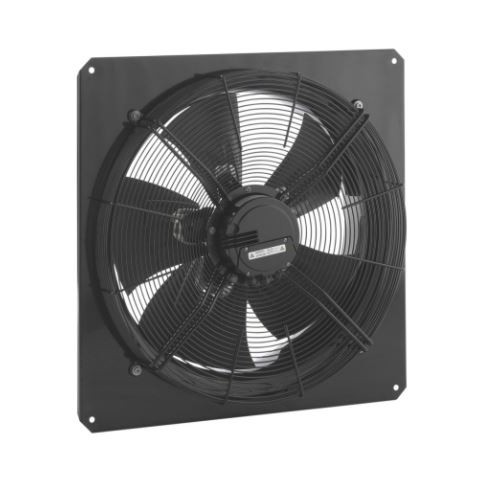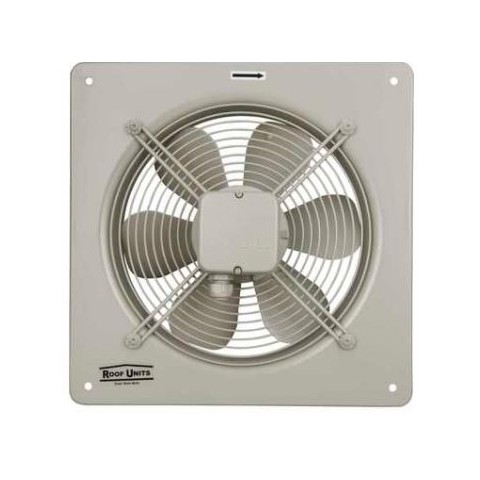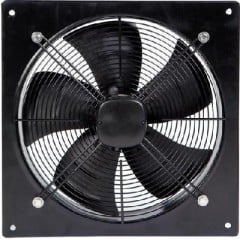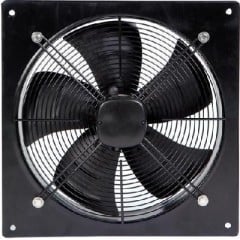Axial Flow Plate Fans
What to Look for When Buying an Extractor Fan
Buying an extractor fan is surprisingly complicated. You can’t just pick up any old fan; you need one that fits on to your wall and into your ventilation duct. You also need to make sure it moves just the right amount of air – not too much, and not too little. It might seem like there isn’t much difference between the fans you’ll see above, but be warned; a few millimetres here and there can mean the difference between a fan that works and one that doesn’t!
Luckily, we’ve got the expert knowledge to help you make the right choice. Read on to learn what you need from an axial flow plate extractor fan.
Plate Size
 The fan itself is mounted inside a square plate. This is what you’ll fit to your wall. Measuring the right-size plate size is obviously quite important – make sure not to get it confused with the fan size, or it might not fit on the wall.
The fan itself is mounted inside a square plate. This is what you’ll fit to your wall. Measuring the right-size plate size is obviously quite important – make sure not to get it confused with the fan size, or it might not fit on the wall.
Fan Size (Diameter)
The diameter of the fan is the size of the fan itself, not the plate that it’s fitted in. Generally, a bigger fan will need to be fitted to a bigger plate.
What Ventilation Rate Do You Need?
The amount of air added to or removed from a space is measured in air change rates. The air change rate (also known as air change per hour) that you need from an extractor fan varies depending on where it’s going to be installed. We strongly recommend you check out this table detailing what air change rate you need in any rooms. Generally, rooms that contain chemicals or machinery – like a dark room or an engine room - will need a higher air change rate.
How to Work Out What Ventilation Rate You Need
Measure the size of the room in m³ (length x width x height). Times this number by the number of air changes per hour you need (check this table) and you end up with the amount of air you need to move in m³.
Fitting Your Fan the Right Way
Axial flow plate fans can be used to suck air out of a room, but they can also be used to suck air into a room as well. This depends on which way you fit your fan. If you fit it “back to front” it’ll work as an air intake – fit it the opposite way to use it as a traditional extractor fan. Be sure to check which is the correct way before installation!
Poles
 Bigger fans move more air, meaning they offer more air changes per hour. However, sometimes you’ll need a larger fan that has a lower air change rate (usually if you’re using it as an intake fan in a smaller room). If this is the case, you should look for one with a number of poles. “Poles” in this case refers to magnetic poles – the magnets are used to slow down the fan as it spins, meaning it moves less air. The more poles it has, the slower it spins.
Bigger fans move more air, meaning they offer more air changes per hour. However, sometimes you’ll need a larger fan that has a lower air change rate (usually if you’re using it as an intake fan in a smaller room). If this is the case, you should look for one with a number of poles. “Poles” in this case refers to magnetic poles – the magnets are used to slow down the fan as it spins, meaning it moves less air. The more poles it has, the slower it spins.
Fan Speed (RPM)
The speed of an extractor fan is measured in RPM. The speed a fan moves at helps determine how much air it moves along with its size, the number of poles it has, and how much power it uses.
IP Rating
IP ratings tell you how well-sealed your extractor fan (or any other electrical appliance) is. It’ll appear as two numbers, for example, IP65. The first number – in our example, 6 – tells you how well-protected the fan is against solid objects like fingers, tools, and dust. The second number – in this case, 5 – shows how well-protected the fan is against liquids. Higher numbers mean better protection.
Heatproof
Depending on where you plan on installing your extractor fan, you may need one that can resist high temperatures. For most purposes, this won’t be an issue as many models can survive above average temperatures, but if you’re installing it in a very hot area, you need to make sure it’s up to the task.
Specialist Fans
Some models are resistant to more than just heat – you can find fans that are flameproof, explosion proof, or anti-corrosive depending on your requirements.
Noise (dBA)
If you want a fan for your home or for a customer-facing business (like a restaurant or takeaway), you need to get something that’s as quiet as possible. Usually (but not always), more powerful fans are louder. Bear this in mind when deciding which one is best for you – try and find the best balance between power, ventilation rate, and noise if you’re looking for an everyday extractor fan.
| Fan Size | Plate Size Square W x H | Voltage | Pole Speed | rpm | Power | Air Capacity m3/s (max) | Quick Code | More Information | Buy Now | |
|---|---|---|---|---|---|---|---|---|---|---|
| Single Phase | ||||||||||
| 250 mm | 10 inch | 370mm x 370mm | 230V | 2 | 2600 | 90 W | 0.35 | 132769 | More info | Buy now |
| 230V | 4 | 1380 | 50 W | 0.21 | 146255 | More info | Buy now | |||
| 315 mm | 12 inch | 430mm x 430mm | 230V | 2 | 2400 | 170 W | 0.54 | 205244 | More info | Buy now |
| 230V | 4 | 1370 | 80 W | 0.42 | 132409 | More info | Buy now | |||
| 350 mm | 14 inch | 485mm x 485mm | 230V | 4 | 1400 | 150 W | 0.72 | 132408 | More info | Buy now |
| 400 mm | 16 inch | 540mm x 540mm | 230V | 4 | 1380 | 180 W | 1.08 | 132250 | More info | Buy now |
| 230V | 6 | 920 | 105 W | 0.8 | 132585 | More info | Buy now | |||
| 450 mm | 18 inch | 575mm x 575mm | 230V | 4 | 1350 | 250 W | 1.36 | 132249 | More info | Buy now |
| 230V | 6 | 920 | 160 W | 1 | 132584 | More info | Buy now | |||
| 500 mm | 20 inch | 655mm x 655mm | 230V | 4 | 1300 | 420 W | 1.96 | 132247 | More info | Buy now |
| 230V | 6 | 920 | 250 W | 1.52 | 132582 | More info | Buy now | |||
| 560 mm | 22 inch | 725mm x 725mm | 230V | 4 | 1300 | 550 W | 1.96 | 132248 | More info | Buy now |
| 230V | 6 | 940 | 280 W | 1.47 | 132581 | More info | Buy now | |||
| 630 mm | 24 inch | 805mm x 805mm | 230V | 6 | 940 | 460 W | 2.59 | 132579 | More info | Buy now |
| Three Phase | ||||||||||
| 500 mm | 20 inch | 655mm x 655mm | 415V | 4 | 1320 | 480 W | 2.01 | 132640 | More info | Buy now |
| 415V | 6 | 900 | 230 W | 1.48 | 132621 | More info | Buy now | |||







